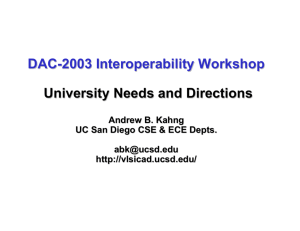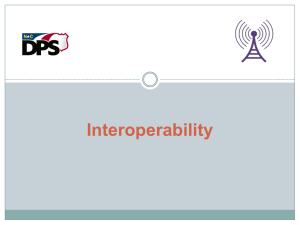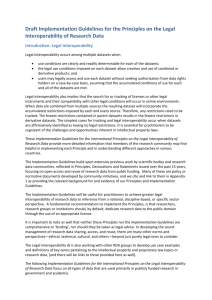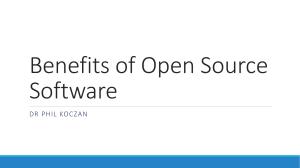Implementation_Guidelines_outline_7March15_draft
advertisement
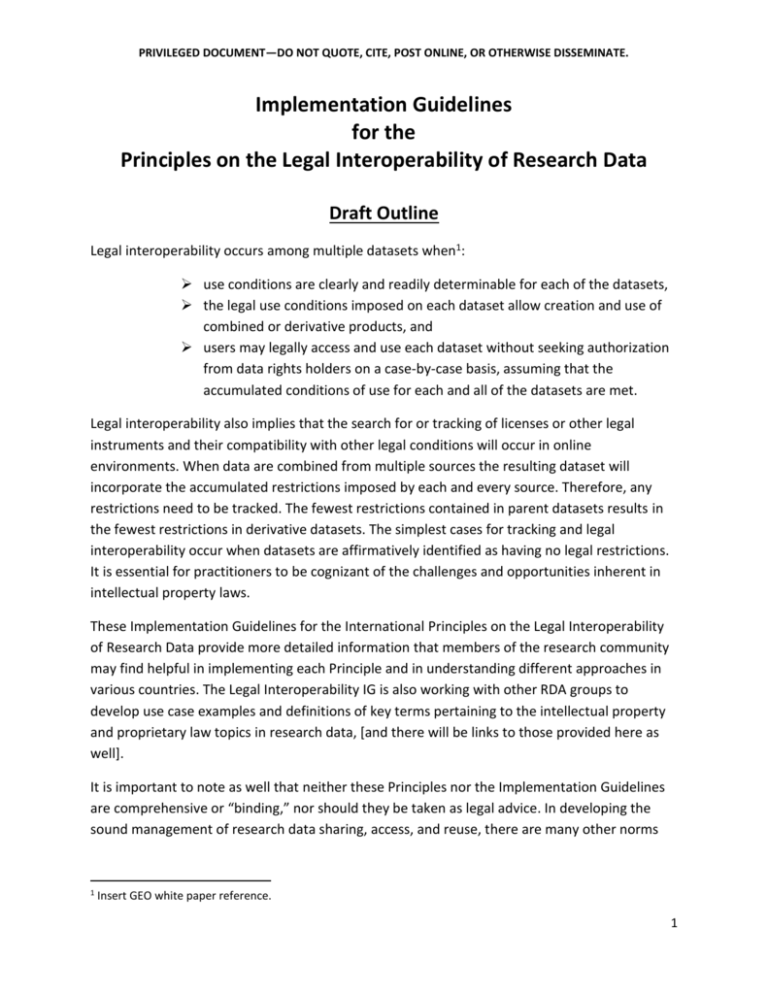
PRIVILEGED DOCUMENT—DO NOT QUOTE, CITE, POST ONLINE, OR OTHERWISE DISSEMINATE. Implementation Guidelines for the Principles on the Legal Interoperability of Research Data Draft Outline Legal interoperability occurs among multiple datasets when1: use conditions are clearly and readily determinable for each of the datasets, the legal use conditions imposed on each dataset allow creation and use of combined or derivative products, and users may legally access and use each dataset without seeking authorization from data rights holders on a case-by-case basis, assuming that the accumulated conditions of use for each and all of the datasets are met. Legal interoperability also implies that the search for or tracking of licenses or other legal instruments and their compatibility with other legal conditions will occur in online environments. When data are combined from multiple sources the resulting dataset will incorporate the accumulated restrictions imposed by each and every source. Therefore, any restrictions need to be tracked. The fewest restrictions contained in parent datasets results in the fewest restrictions in derivative datasets. The simplest cases for tracking and legal interoperability occur when datasets are affirmatively identified as having no legal restrictions. It is essential for practitioners to be cognizant of the challenges and opportunities inherent in intellectual property laws. These Implementation Guidelines for the International Principles on the Legal Interoperability of Research Data provide more detailed information that members of the research community may find helpful in implementing each Principle and in understanding different approaches in various countries. The Legal Interoperability IG is also working with other RDA groups to develop use case examples and definitions of key terms pertaining to the intellectual property and proprietary law topics in research data, [and there will be links to those provided here as well]. It is important to note as well that neither these Principles nor the Implementation Guidelines are comprehensive or “binding,” nor should they be taken as legal advice. In developing the sound management of research data sharing, access, and reuse, there are many other norms 1 Insert GEO white paper reference. 1 PRIVILEGED DOCUMENT—DO NOT QUOTE, CITE, POST ONLINE, OR OTHERWISE DISSEMINATE. and perspectives--ethical, technical, cultural, and others—beyond just purely legal ones to consider. The following Implementation Guidelines for the International Principles on the Legal Interoperability of Research Data focus on all types of data that are used primarily in publicly funded research in government and academia: 1. Access and Reuse Facilitate access to and reuse of research data. In order to enable the maximum degree of interoperability, access to and reuse of research data should be either unrestricted by default or otherwise be granted to users with the fewest limitations possible. Data in the public domain ensures that there are no restrictions. Implementation Guidelines There are many Principles, Declarations, and Statements that have been issued over the past 15 years focusing on open access and unrestricted reuse. Although these are mostly policy or normative documents developed from the bottom up, we cite and link to them here as providing the relevant background for and evidence of our first Principle. They are useful for practitioners who are implementing approaches for the legal interoperability of research data to reference from a national, discipline-based, or specific sector perspective. a. b. c. d. e. f. g. h. i. j. k. l. m. n. Budapest, Bethesda, Berlin, Salvador, and Nairobi Declarations Bermuda, Ft. Lauderdale, Toronto genomic data Declarations Bromley Principles on global change research data Group on Earth Observations Principles and Implementation Guidelines CODATA Statement UNESCO Statement GBIF and Bouchon biodiversity data Declarations OECD Guidelines on research data and public sector data OKFN open government data Principles EUDAT WG on Data Access and Re-use OpenAIRE Statement Belmont Forum Statement The Hague Declaration Policy Recommendations for Open Access to Research Data in Europe (RECODE Project) o. UCLA group (?) Other discipline-specific declarations, principles, etc? Other national/regional (e.g., EU) declarations and principles? Other issues to cover here? 2 PRIVILEGED DOCUMENT—DO NOT QUOTE, CITE, POST ONLINE, OR OTHERWISE DISSEMINATE. 2. Balance Balance the legal interests. Freedom of access and reuse of research data that enables legal interoperability must be balanced against legitimate interests to withhold or restrict such data, or control the use of data by the rights holders. Legitimate interests vary by jurisdiction and situation, but generally reflect laws or established norms regarding protection of [intellectual property rights], national security, personal privacy, confidentiality, endangered species or cultural resources, and defined periods of exclusive use prior to the publication of research results. Implementation Guidelines Despite Principle 1 above on open access and unrestricted reuse of research data as a default rule, there are numerous legitimate countervailing laws, policies, and norms that are superseding. Below we describe and link to some of those countervailing interests, although the user is cautioned [to research the area thoroughly and seek professional legal advice] before reusing or sharing any data or information that is not accompanied by documentation that expressly states the provider and user rights. a. Intellectual property rights - Copyright - Database rights - Restrictive contracts and licenses - Other b. National security laws c. Personal privacy protection d. Confidentiality laws and policies e. Protection of endangered species f. Protection of cultural resources g. Defined periods of exclusive use of research data h. Other [?[ 3. Harmonization Promote harmonization of rights in research data. Governments, institutions, and individual researchers should facilitate legal interoperability using compatible and consistent terms and conditions for research data across as many jurisdictions as possible. Possible mechanisms for achieving such harmonization include treaties, legislation, public policy, common-use licenses, and waivers of rights. In harmonizing laws and policies, including statutory limitations and exceptions, stakeholders need to 3 PRIVILEGED DOCUMENT—DO NOT QUOTE, CITE, POST ONLINE, OR OTHERWISE DISSEMINATE. take into account prevailing practices, norms, and other factors relevant to the research community. The goal of standardization must be balanced against the need for flexibility. Implementation Guidelines This is a confusing area of laws, policies, and practices that are far from complete and will require considerable attention in the future. Harmonization can be implemented from the top-down and the bottom-up, with each approach having specific benefits and drawbacks. The discussion that follows is organized principally from the top-down and bottom-up perspectives, but cannot discuss the nuances that different disciplines may have in implementing such harmonization. a. Top-down approaches - Treaties - Legislation - Governmental policies - Government contracts and grants b. Bottom-up approaches - Institutional policies - Institutional and individual common-use licenses - Institutional and individual waivers of rights [Other considerations?] 4. Transparency and Certainty State legal rights clearly. An unambiguous articulation or labelling of rights and policies governing all datasets used in research is essential to provide sufficient notification of the legal rights (if any) retained by the original rights holder. The legal terms and conditions for legal interoperability of those data must be clearly stated. Legal transparency and certainty minimizes legal exposure to risk for all parties, removes barriers to research, and facilitates the long-term access and use of data resources, including for those data in the public domain. Implementation Guidelines The first three Principles described laws, policies, and practices that are relevant to the user of any data source in understanding the rights and responsibilities in its potential for reuse, including its legal interoperability. Many of the relevant laws and policies are not restated in conveying the data to the user. Despite the old legal principle that ignorance of the law is no excuse, users cannot be expected to be experts in the intricacies of all the relevant laws and policies. It is therefore incumbent on the provider 4 PRIVILEGED DOCUMENT—DO NOT QUOTE, CITE, POST ONLINE, OR OTHERWISE DISSEMINATE. of the data to state the access and reuse rights clearly. This can be done through accompanying common-use licenses or waivers of rights. [Discussion] 5. Metadata Improve metadata to enhance legal interoperability. The metadata for any publicly available dataset should include all relevant information on data ownership, rights, licenses, and restrictions, ideally in machine-readable form using available standards. All metadata for a dataset should be freely accessible with no legal restrictions imposed on the use of the metadata. Implementation Guidelines Metadata are the principal mechanism through which Principle 4 on transparency and certainty can be achieved. There are several metadata standards and conventions, some of which are discipline-specific. Apart from the common-use licenses and waivers of rights discussed above, however, these do not generally address the legal rights of users in reusing, sharing, or combining the data with other sources. [Discussion] 6. Attribution and Credit Reaffirm the value of giving credit. Attribution and citation are an essential part of the research process for providing appropriate credit, especially when data from different sources are incorporated into a dataset or database. They should be encouraged through community norms rather than through legal requirements. Implementation Guidelines Appropriate attribution and credit for providing a well-prepared, quality dataset is essential to the scientific process. There is a difference of opinion though about whether to make attribution an express legal requirement or simply leave it to the norms of the research community. [Discussion] 7. Equity Promote equitable access and use. In asserting any rights and in applying access and reuse terms and conditions to any dataset made publicly available, all members of the research community should make such data available equitably to all users, including the most disadvantaged ones, and to share the benefits from the use of such data. 5 PRIVILEGED DOCUMENT—DO NOT QUOTE, CITE, POST ONLINE, OR OTHERWISE DISSEMINATE. Implementation Guidelines Equity and fairness are important qualities for research conducted with public support especially in the public interest. There are not many expressions of such a principle in laws and policies at either an international or national level. These also are not legal requirements, but ethical or normative ones. There are differences among types of research or discipline area as well. [Discussion] 8. Responsibilities Encourage responsibility. All members of the research community need to be fully informed about the laws, policies, and norms pertaining to the data they produce or use, and should engage directly in the applicable legal, policy, and community processes governing research data. Implementation Guidelines As has already been stated, ignorance of the law is no excuse. This is true of all people, whether they are working in their own jurisdiction or in another one. In many ways, the familiarity with the norms and practices of one’s own areas of research and the data used in that area is better than with the laws and policies, even within one’s own locale. For this reason, this Principle is directed at all members of the research community. Every person in the research process has some responsibility to access, use, share, and combine research data. [Discussion] 6

